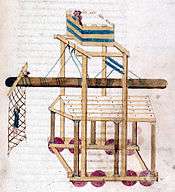Hero of Byzantium

Hero of Byzantium (or Heron of Byzantium or sometimes Hero the Younger) is a name used to refer to the anonymous Byzantine author of two treatises, commonly known as Parangelmata Poliorcetica and Geodesia, composed in the mid-10th century and found in an 11th-century manuscript in the Vatican Library (Vaticanus graecus 1605).[1] The first is a poliorketikon, an illustrated manual of siegecraft; the second is a work in practical geometry and ballistics, which makes use of locations around Constantinople to illustrate its points. The manuscript consists of 58 folios and 38 colored illustrations.
The Parangelmata Poliorcetica was an adaptation of an earlier (c. 100) poliorcetic manual of Apollodorus of Damascus, but in place of the static, two-dimensional diagrams of that work, the Byzantine author used a three-dimensional perspective and scaled human figures to clarify the passages. As artillery had not yet become a factor in siegecraft, the machines themselves tend to be those useful for advancing a force up to fortifications and mining them once situated. Hero includes tortoises (Greek: χηλῶναι—mobile sheds used to protect troops from attack while approaching fortifications); a new Slavic style of tortoise called the laisa (Greek: λαῖσα), created from interwoven branches and vines; palisades; rams; ladders; nets; towers; bridges; and tools such as augers and bores.[2] In addition to the work of Apollodorus, the author also draws on the work of Athenaeus Mechanicus, Philo of Byzantium, and Biton.[3]
Edition
- Sullivan, Dennis F., ed. (2000). Siegecraft: Two Tenth-Century Instructional Manuals by "Heron of Byzantium". Dumbarton Oaks Studies XXXVI. Washington, DC: Dumbarton Oaks Research Library and Collection. ISBN 0-88402-270-6.
Sources
- ↑ Sullivan, Dennis F., ed. (2000). Siegecraft: Two Tenth-Century Instructional Manuals by "Heron of Byzantium" (PDF). Dumbarton Oaks Studies XXXVI. Washington, DC: Dumbarton Oaks Research Library and Collection. pp. 1, 3–4. ISBN 0-88402-270-6.
- ↑ McGeer, Dennis (1995). "Byzantine Siege Warfare in Theory and Practice". In Corfis, Ivy A.; Wolfe, Michael. The Medieval City Under Siege. Woodbridge, Suffolk: Boydell Press. pp. 124–125. ISBN 0-85115-561-8.
- ↑ Sullivan (2000), pp. 1–2.